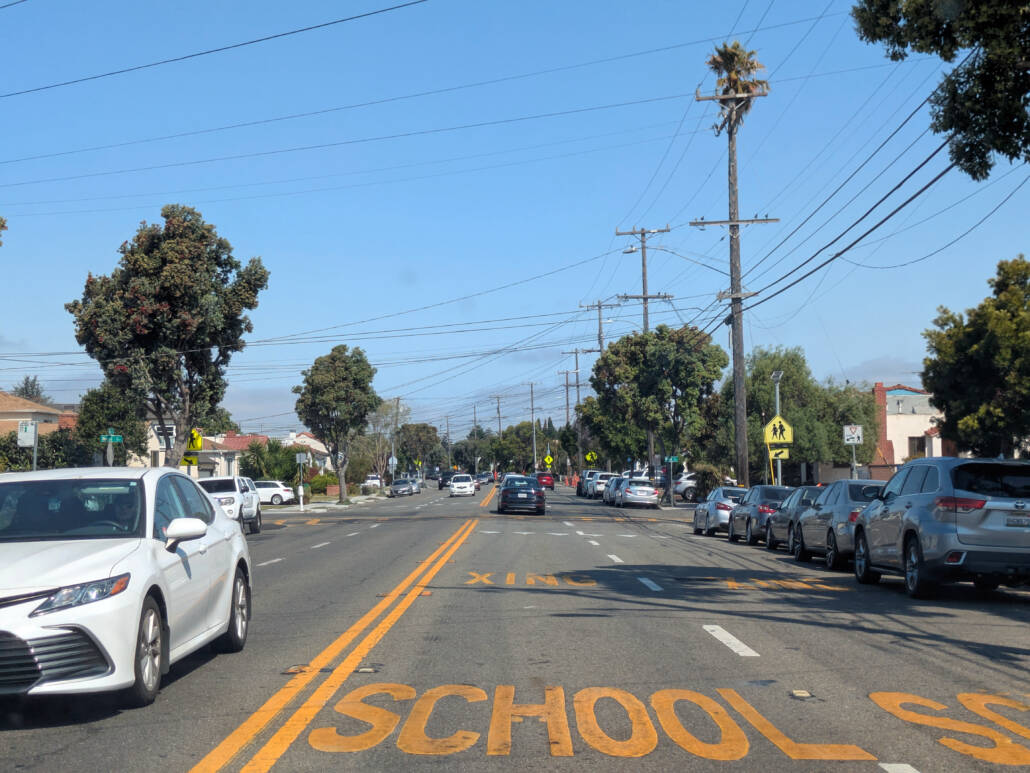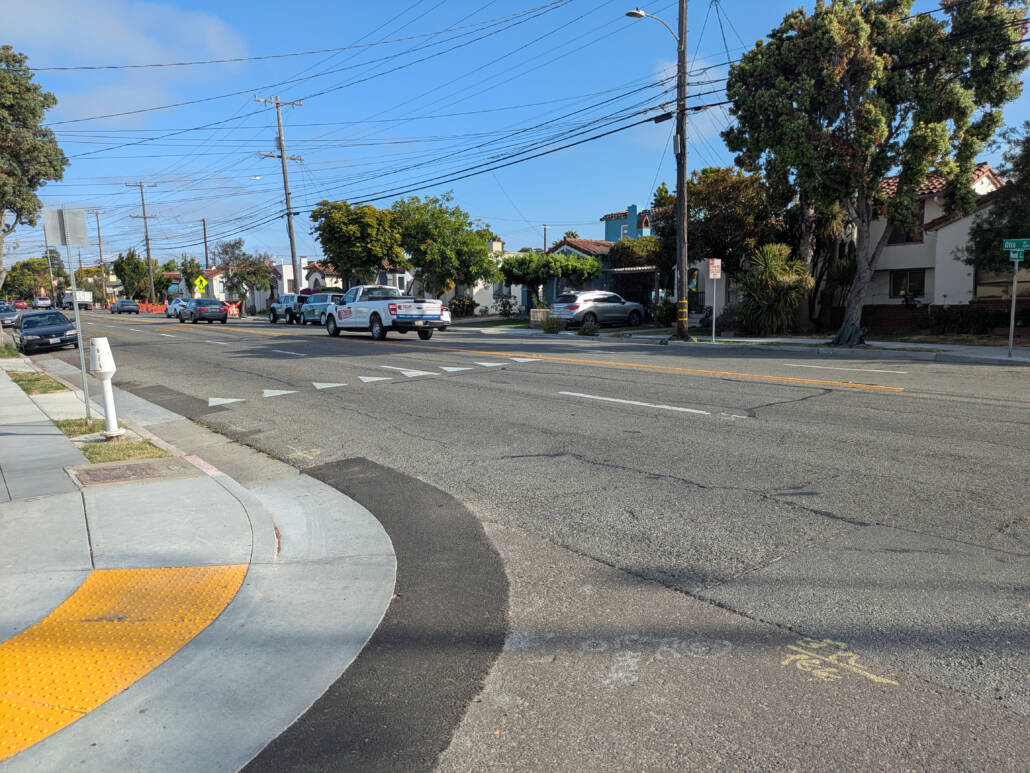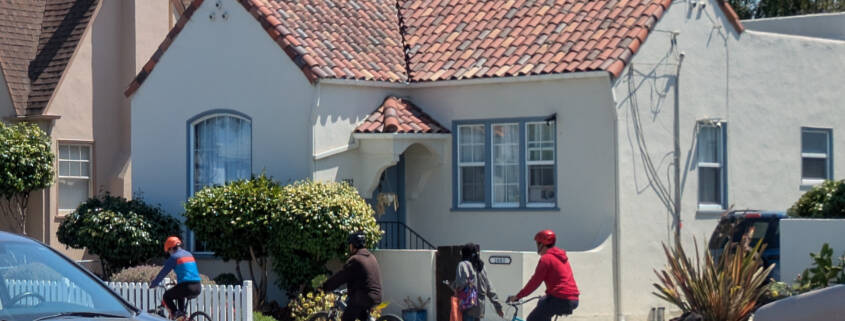Adding Bikeways to State Routes: Two Local Advocates Share Strategies for Change
Getting bikeways, crosswalks, or other Complete Streets elements into a Caltrans project can be challenging. Convincing Caltrans to alter a previously approved project to add bikeways is an even bigger lift, but local advocates in the East Bay did just that. We spoke with Robert Prinz, Bike East Bay’s advocacy director, and Drew Dara-Abrams, who sits on the City of Alameda Transportation Commission, about what worked to get Caltrans to change its plans.
The project: SR 61 from San Leandro to Alameda
The project, approved in the 2020 State Highway Operation and Protection Program (SHOPP), would repave State Route 61 from Davis Street in San Leandro, where it’s named Doolittle Drive with a 45-50 mph speed limit through Oakland, and across a bridge to become Otis Drive in Alameda, then move over to Encinal Avenue, bisecting the island city.
The most cost-effective time to build new bikeways is during repaving or repair work. CalBike’s Complete Streets bills all called for including Complete Streets in SHOPP projects. Yet getting Caltrans to take the infrastructure needs of people biking and walking seriously when planning projects that impact local streets has been a challenge. CalBike’s Incomplete Streets Report highlighted some of the excuses the agency has used to shortchange active transportation. With the passage of SB 960, the Complete Streets Bill, we are optimistic that Caltrans will do better on future projects.
But that doesn’t solve the problem of SHOPP projects approved in the past, some of which are only now being constructed. With SR 61, advocates faced the challenge of getting present-day Caltrans to honor Complete Streets obligations in a project initiated by past Caltrans. Here’s how they did it.
San Leandro to Oakland: Bike East Bay
Bike East Bay’s Robert Prinz worked mainly on the San Leandro and Oakland segments of the project, while local advocates in Alameda took the lead on the segment running through that city. The Project Initiation Document (PID), completed in 2020, failed to reference local bike plans from Oakland and San Leandro calling for protected bikeways on Doolittle Drive, even though the bike plans predated the PID. Bike East Bay pointed this out to Caltrans; Prinz has email threads going back to 2020. It took until 2024 for Caltrans to agree to reconsider the plan.
This segment covers a gap in the Bay Trail, a biking and walking trail that is envisioned to one day provide an unbroken route around the San Francisco Bay. While a future Bay Trail segment is planned to connect to Alameda, a protected bikeway on Doolittle closes a “gap between where one part of the Bay Trail ends and another begins,” Prinz said, noting that there’s no room for a Class I separated path in this area, so a Class IV protected bikeway is critical.
Prinz noted that some SHOPP projects do a good job with active transportation infrastructure, but the process could use more transparency. “We’ve had some good SHOPP projects funded, and it’s just a mystery as to why,” he said, citing a $40 million Complete Streets project in Union City and Fremont that he didn’t know was in the pipeline.
The breakthrough for Prinz was getting Caltrans to come to a meeting of the Infrastructure Committee he chairs on Oakland’s Bike/Ped Advisory Commission. It was hard for Caltrans staffers to refuse — their office is just two blocks from OakDOT’s. “Later we learned that Oakland DOT staff had been saying the same thing to Caltrans,” he said, noting that “ultimately I think it was Caltrans hearing from a lot of different partners” that got them to add a bikeway to the plan.
Prinz also cited the local bike plans as essential to the process with Caltrans. “Plans matter,” he said. “Very often, plans get overruled, but it does still help if you can point to something in one or more adopted plans to back up your requests.” He added, “Individual design details are important, and I wish we could spend more time working on that.” Making sure the bikeway is usable and “not just a line on a map,” he said, is just as important as the bikeway class, noting that some of Oakland’s bike lanes have had to be upgraded multiple times as design standards change.
He also cited the value of having more pools of advocates when working on a cross-jurisdictional project like this one. He hopes to see more advocates looking across borders and joining forces to work on projects that span multiple cities because “most people don’t bike in only one city.”
Alameda: Drew Dara-Abrams
Drew Dara-Abrams describes the four-lane state route that cuts across Alameda as running next to a city park, an elementary school, and houses with minimal setbacks. It’s the kind of roadway where cities like Alameda have consistently added bulbouts and other traffic calming features.
Not so with the Caltrans project. “Caltrans is stuck in the past of auto throughput, auto throughput, auto throughput,” he said. “Compared with all the design aspects we can expect to be part of a process for locally controlled roads, it’s just a black box.” When he first reached out to Caltrans to ask why project plans didn’t reflect statewide Complete Streets policies adopted in 2021, district staff said certain project documents were filed internally in 2019 and therefore avoided all subsequent requirements — including policies requiring sign-off on Complete Streets reviews by their district leadership.


Photos of Otis Drive in Alameda courtesy of Drew Dara-Abrams.
Like Prinz, Dara-Abrams also found that getting Caltrans staff to a public meeting was crucial. Holding a City of Alameda Transportation Commission meeting on the project “enabled residents to write in and attend and speak,” he said. “That really brought some light to the project.” They got 40 pages of emailed comments, including a letter from the principal of the neighboring elementary school. Public awareness and input didn’t move Caltrans, but it moved local leaders to meet with Caltrans staff, which was an important part of the process.
Dara-Abrams began writing about the project on his blog in 2023 and describes his advocacy as “pingponging back and forth between different groups and local leaders, which helped elevate this and make the local Caltrans district care at a leadership level.” Involving Caltrans leadership was crucial. “It turned out city staff and Caltrans staff had been going back and forth about the project for years,” he said. “The impetus for change has to come from the leadership level to give them permission to do things that might take a little more time or a little more budget.” With public scrutiny, Caltrans could no longer ignore local staff.
He said getting to know local staff was crucial because they know what projects are coming up. He’s learned from them and given himself an education in reading complex Caltrans and CTC documents.
In the short run, the changes make Caltrans staffers’ jobs harder, Dara-Abrams says, but “in the long run, this is in Caltrans’ interest — getting these details right.”
CalBike: Support from the statewide bike coalition
While local advocates took the lead in working with Caltrans on the SR 61 project, CalBike played a supporting role. We wrote letters of support and helped open lines of communication with Caltrans staff, while continuing to put pressure on district and headquarters regarding their CS policies and SB 960, which was signed into law during this time.
Hearing a similar message from a number of organizations let Caltrans know that people were paying attention and helped elevate the message up the chain of command to key decision-makers. This included an official response letter from then-District 4 Caltrans Director Dina El-Tawansy, who has since been promoted to Caltrans director at headquarters in Sacramento.
“The work Robert and Drew did on this project shows what’s possible if you’re persistent in working with Caltrans,” said Jared Sanchez, CalBike policy director. “I hope to have the opportunity to support more local advocates in finding the right levers to apply pressure to improve local projects.”
Results and takeaways
For both segments of the project, the advocates didn’t get everything they wanted. On Doolittle Drive, the bike facility won’t be very wide and doesn’t provide separation as robust as many other new East Bay bikeways. But, Prinz said, “It’s all iterative. We want Caltrans staff to get more experience with this kind of stuff, and we’ll get them to beef it up at some point.” And, once complete, this will be one of the longest Class IV bikeways in Oakland, and the only one east of Fruitvale Avenue.
In the Alameda segment, there will be small but targeted additions of pedestrian refuge islands and curb extensions at popular intersections, which fell short of the lane reductions local advocates wanted. But they got a promise from Caltrans District 4 to study a road diet and potentially implement lane reductions. That project is expected to get programmed into the 2028 SHOPP with construction in 2032, moving at the normal, glacial pace of Caltrans projects. CalBike’s Quick-Build Bill could provide more momentum, especially for projects that address safety hazards for vulnerable road users. The bill would allow Caltrans districts to use quick-build methods, when warranted, to swiftly address dangerous roadways.
“The fact that Caltrans was willing to update their plans at all is progress,” Prinz said. “It’s been a long process, but thanks, Caltrans, for listening.”
Key takeaways from this project:
- Take your concerns to district leadership, and also reach out to staff at Caltrans headquarters and the California Transportation Commission, which provides funding for SHOPP projects.
- Hold public meetings with Caltrans staffers present to hear comments and answer questions.
- Ask Caltrans staff for project initiation documents, traffic analyses, and engineering plans. Use these materials to ask targeted questions and propose specific improvements.
- Be persistent. Working with Caltrans is a long-term project.
- Find your allies. Work with city staffers, elected officials, other advocacy groups, and people who live in adjacent cities or neighborhoods toward your shared goal of safer streets and connected bike routes.
CalBike continues to work at the state level to implement better policies on our state-controlled streets. Those policies pave the way for more transparency at Caltrans and a greater role for local communities in shaping the roads that run through their neighborhoods.





